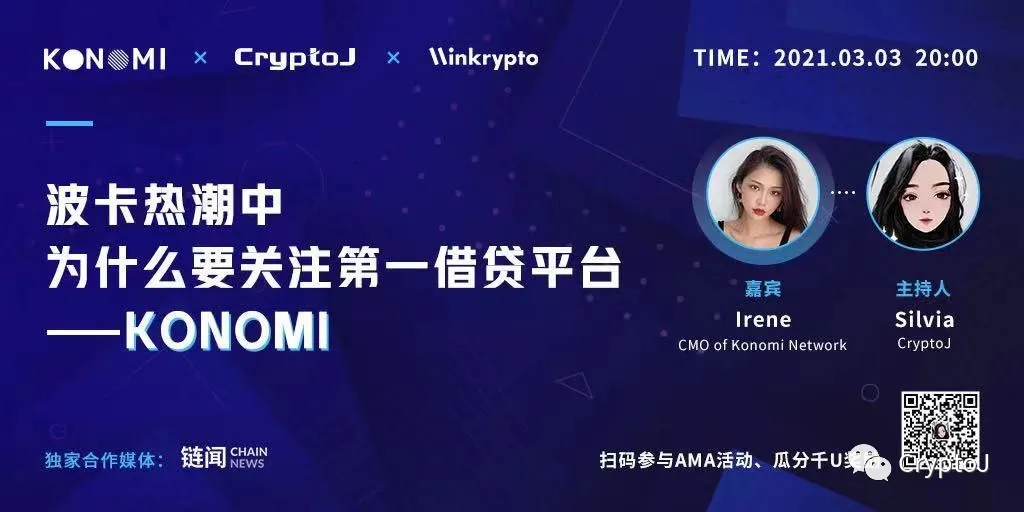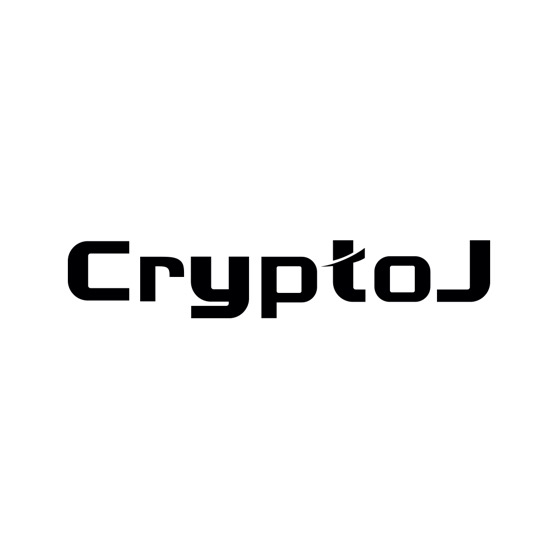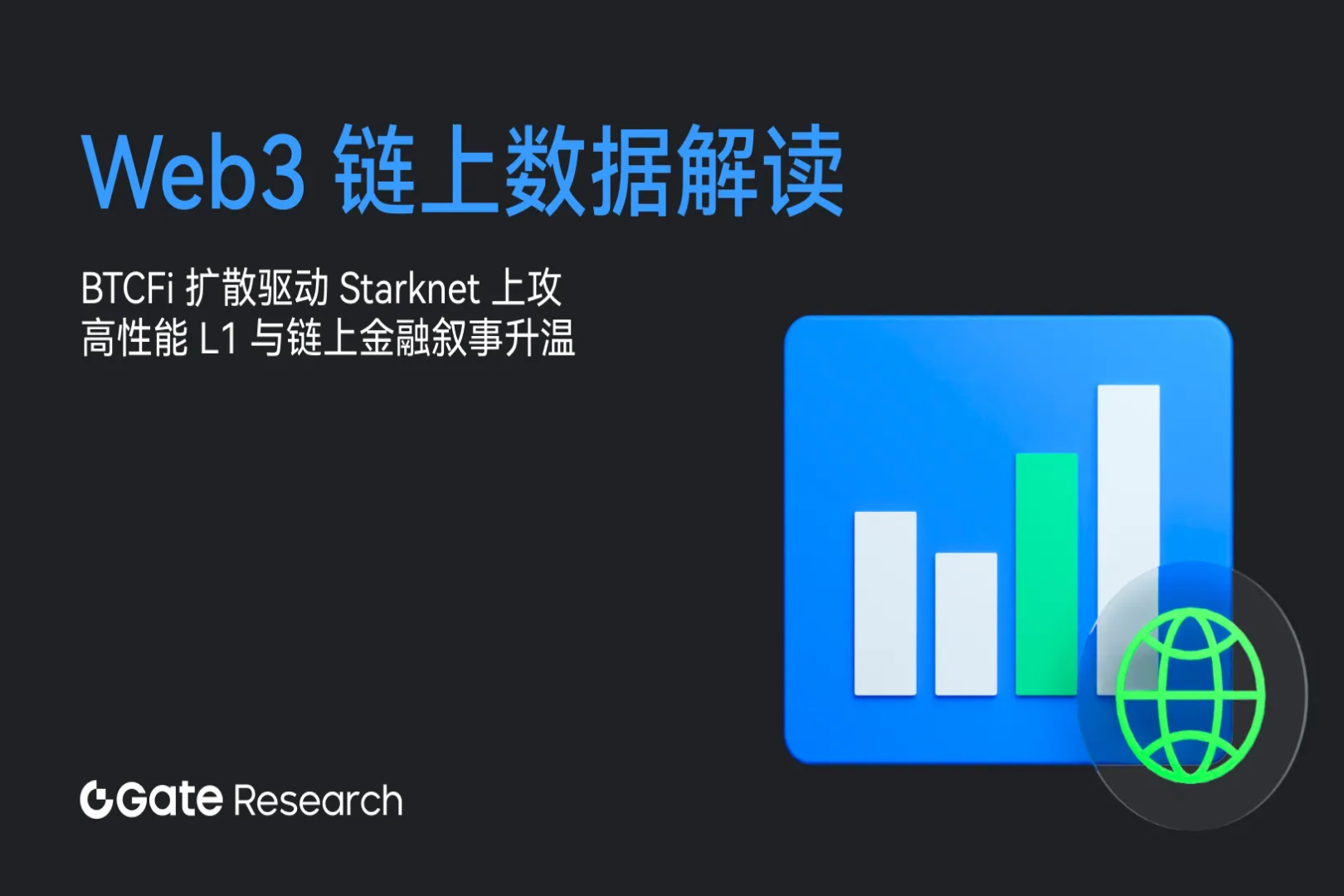Why pay attention to the lending platform KONOMI in the Polkadot craze
Irene: The goal of KONOMI is to help users invest, trade and manage assets in an efficient manner. With the release of the Polkadot parachain and the inter-chain communication protocol taking effect, KONOMI can support more financial products for the Polkadot ecosystem.
On March 3, 2021, CryptoJ invited Irene, the chief marketing officer of KONOMI, to the CryptoJ community to hold an AMA titled "Why should pay attention to the number one lending platform-KONOMI in the Polkadot craze". This is the first appearance of KONOMI after announcing the financing information. Irene mainly conducted a detailed and in-depth discussion on KONOMI's team background, mission, advantages, economic model and future development.

secondary title
Question 1: First of all, please introduce yourself and the other team members of KONOMI, and what is the reason for everyone to participate in the KONOMI project?
Irene: Several of our founding team members are all classmates at the National University of Singapore. When we were in college, we wanted to have the opportunity to get together to do something valuable. It just so happens that our backgrounds are relatively complementary. When CEO Ariel proposed to us to start a business together and start KONOMI, we were very excited and joined without hesitation.
I have been working and starting a business in Singapore since graduation. With 7 years of experience in social media and community operations, before joining KONOMI, I was a business broker in the field of physical commodity trading. As the founder of a sole proprietorship, I established partnerships with more than 100 companies and approached many Online promotion campaign.
Our CEO Ariel Ho has been investing in the encryption field since 2017 and has seven years of experience in technology startups. Before joining KONOMI, she founded High Mall Indoor Navigation, a technology solutions provider for NTUC Fairprice, Singapore's largest supermarket chain.
secondary title
Question 2: Can you briefly introduce KONOMI to our community partners? What problem does it solve? And what is its vision and mission?
Irene: KONOMI is a public chain developed based on Substrate. The first and most important product based on KONOMI is a decentralized lending application.
Our team believes that the lending layer protocol is the infrastructure of decentralized financial applications, on which more "building blocks" can be carried - such as asset management and derivatives trading protocols. We want to do a good job at the bottom layer, and at the same time serve other application layers developed on our chain, and truly provide Polkadot ecological users with smooth cross-chain asset transactions and management products.
The vision of KONOMI at the beginning of its establishment was to enable financial applications on Ethereum to seamlessly connect to the Polkadot ecosystem, and to provide users with a complete asset management experience—from liquidity agreements, to lending markets, to the management of ecological assets .
Because Polkadot has better performance, and there are more application scenarios different from Ethereum in terms of governance and parachain auctions, we believe that Polkadot-based financial applications will also have richer gameplay than Ethereum. Therefore, in terms of product design, we first built the underlying facilities: decentralized liquidity agreement and lending agreement.
secondary title
Question 3: Why did KONOMI choose Polkadot? From your point of view, what is the current ecological development of Polkadot? What is the difference and gap with Ethereum?
Irene: We always believe that the Polkadot ecology has the opportunity to subvert Ethereum and become the underlying protocol of Web3.0. At present, we think that the Polkadot ecology is still in a very early stage, but this also provides projects including us opportunity for development.
Many Polkadot ecological projects are referring to and learning from the Ethereum ecology, which we believe is the only way for an early ecology. However, as parachains and other infrastructure become more mature, we believe that more native Polkadot applications will be generated to solve the current problems of Ethereum applications, and even provide some services that were completely impossible to implement on the blockchain before. and products.
secondary title
Question 4: We know that there are already leading projects such as Compound, Aave and MakerDAO in the Ethereum ecosystem. What is the uniqueness of KONOMI compared with them? Compared with these leading projects, what is the competitive advantage of KONOMI?
Irene: Compound is the first widely used financial market protocol on Ethereum, which makes digital assets truly have currency attributes. With the issuance of Compound's governance assets, DeFi applications have also ushered in a wave of liquidity mining frenzy, pushing the assets of the DeFi protocol to a new height.
The biggest difference between KONOMI and Compound is that KONOMI is an independent Substrate-based chain rather than just an application.
Because Compound is based on Ethereum, this naturally brings many restrictions to the project-such as fee settings, supported asset classes, and so on.
As an independent chain, KONOMI can support the development and deployment of other DeFi applications on the chain to achieve better synergies.
In addition, in Compound's token economic model, COMP only supports the scenario of decentralized governance, and cannot continuously generate incentives for users and encourage users to participate in platform construction.
From the perspective of economic model design, KONOMI has designed a profit repurchase and rate discount mechanism to provide users with more application scenarios and make liquidity incentives more sustainable.
At this stage, DeFi lending projects can be roughly classified as follows:
1) Loan-only mode: MakerDAO
MakerDAO is a long-established DeFi project on Ethereum. It has two tokens, ETH and DAI, in its fund pool. Lenders lend DAI, the stable currency issued by the MakerDAO platform, by mortgaging ETH, but users cannot lend personal assets on MakerDAO. MakerDAO's lending function is relatively simple and cannot meet most market needs.
2) Liquidity pool lending: KONOMI, Compound, Aave, etc.
Compound’s liquidity pool lending is much more optimized than the above-mentioned lending model. The most obvious feature is that the fund lender and the lender can be regarded as two liquidity pools respectively. The loan demand is carried out in the liquidity pool, and the loan interest rate and collateral value are automatically adjusted according to market demand through smart contract algorithms.
KONOMI not only inherits the advantages of Compound’s liquidity pool lending mechanism, but also makes it possible to provide lending services for the entire encrypted asset market based on Polkadot’s cross-chain characteristics.
Polkadot-based KONOMI has more advantages in this regard, the rate update speed will be faster, and the curve will be relatively smoother. KONOMI currently adopts the method of mortgage lending, which requires users to over-mortgage.
Along with the improvement and promotion of DID's decentralized identity infrastructure, KONOMI will also design a reputation mechanism to reduce the burden on mortgages for reputable users.
secondary title
Question 5: With the rapid development of DEFI recently, the performance bottleneck and high cost of Ethereum have caused everyone to complain. Recently, many DEFI projects have moved to the BSC Binance Smart Chain and HECO Huobi Ecological Chain, as well as Compound. What do you think about developing a public chain by yourself, or some DeFi projects make their own Layer 2 solutions? If the above scheme is realized, will it pose a challenge to Polkadot-based projects in terms of performance?
Irene: For many leading DeFi projects, we believe that choosing the public chain and layer2 is a solution to the current high price of Ethereum.
The cost of hundreds or thousands of RMB for a single transfer makes ordinary users discouraged from using DeFi on Ethereum. In order to attract more users, the DeFi protocol can only find other ways—or the second layer, or other public chains , or build a public chain by yourself.
Regarding the Layer 2 network, we believe that the current technology is not very mature. For users, there is a delay in the withdrawal time and confirmation time, which is not a good overall experience; and the transaction volume of the second layer is still relatively low, and it is impossible to judge the future after more applications choose the second-layer solution. network stability.
secondary title
Question 6: How is KONOMI's token economy designed? What is the main purpose of the token? In order to allow early participants to obtain corresponding returns, KONOMI’s native token KONO not only has community governance rights, but holders can also participate in pledge lending to obtain platform fee sharing.
Irene: In its economic model design, there is also a clear repurchase mechanism for KONO, which is also obviously different from Compound. With more and more participants, I believe that the price of KONO will also get better and better.
Main token usage:
User Incentive Mechanism: KONOMI will give token rewards to users who provide early liquidity and asset mortgages for the protocol to facilitate the rapid development of the platform;
Asset mortgage: KONOMI tokens can be used as mortgage tokens to share platform revenue and ensure the security of debt warehouses;
Governance: Token holders can initiate proposals and vote on issues such as token incentive mechanism, transaction fee rate, supporting assets, and technology development priorities;
secondary title
Question 7: How is KONOMI's token distribution plan designed? For example, many DeFi applications now distribute tokens through user incentive plans. Does KONOMI have such a design?
Irene: KONOMI issued a total of 100 million KONO tokens, and the specific distribution plan is as follows:
15% of the tokens are used as platform user incentives. After the platform goes online, a user incentive plan will be launched to attract users/funds to the KONOMI platform;
16% of the tokens are used for ecosystem construction, the integration of main users with the Polkadot ecosystem, and tokens such as the auction incentives for the team participating in the Polkadot parallel chain are also from this part;
21% of the tokens were sold to private investors for early financing;
18% of the tokens are used for marketing, including project community incentives, marketing plans after the platform goes online, etc.;
15% of tokens will be used as reserved tokens of the foundation;
secondary title
Question 8: Is it convenient to tell you about the fundraising situation of KONOMI? I think everyone is also concerned about whether there is a public offering plan in the future.
secondary title
Question 9: What do you think of Polkadot’s parachain auction? Will you participate in parachain auctions?
Irene: We believe that Polkadot’s parachain auction is a very important node for the development of the Polkadot ecosystem, which means that the Polkadot ecosystem will begin to support native assets and assets of other chain ecology.
The launch of the parachain is also a counterattack to those who are not optimistic about Polkadot's ecology - everyone will really feel Polkadot's consensus speed, governance process and cross-chain communication functions.
Polkadot's parachain auction is actually a way for the project party to lock DOTs to participate in the auction to obtain the right to lease the slots. After the lease period ends, the locked DOTs will be automatically returned to the original account.
Because slots are relatively scarce, the cost of bidding for a slot is relatively high. The project party can help them bid by attracting DOT holders to lock DOT, and use their own native tokens to reward those who help them bid.
secondary title
Question 10: There are more and more DeFi projects in the Polkadot ecosystem recently. What do you think of the follow-up DeFi in the Polkadot ecosystem? Can it be as powerfully composable as the DeFi of the Ethereum ecosystem?
Irene: We believe that Polkadot's DeFi ecological development will be divided into three stages: copying Ethereum, paralleling Ethereum, and generating new models.
At present, we are still in the first stage of replicating the ecological application of Ethereum. With the launch of the parachain, more and more assets will be issued in the Polkadot ecosystem, and they will also be assembled into financial Lego like the previous ETH DeFi to provide support for projects in the ecosystem.
The second stage is parallel to Ethereum. With the completion of the ETH/DOT bridge, we will see more Ethereum applications choose Polkadot as the underlying platform, and DOT will also become an ecology parallel to ETH.
secondary title
Question 11: What is the current development progress of KONOMI? I heard that the testnet deployment is about to start, when will the follow-up products be officially launched?
Irene: There are five main components in the technical design of KONOMI, and the first three components have been completed so far, namely:
Asset component: automatic market-making and lending components that support multiple assets;
Automatic market-making component: an asset exchange protocol similar to Uniswap, which supports users to perform asset exchange, add and remove liquidity operations;
Lending component: This is the key and unique feature of KONOMI, which will support various types of lending pools. Users can mortgage assets in these pools to obtain interest. If users have enough collateral, they can also lend other assets in the pool and pay some interest at the same time.
At present, we have completed the development of the lending module, including the liquidation model designed by the team, which has been integrated into the lending module. In addition, we have also developed an oracle machine using Substrate offworker to feed assets in real time. KONOMI will invite some users to participate in our testnet by invitation in the near future, and the specific rules of the event will be synchronized on the official social media later.
About KONOMI
Official website: http://konomi.network
Medium: https://medium.com/konomi
Telegram: https://t.me/konominetwork
Twitter: https://twitter.com/KonomiNetwork



